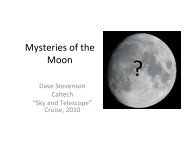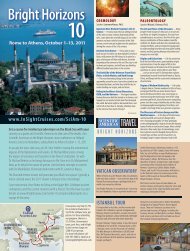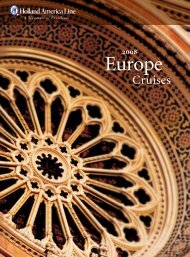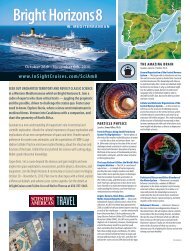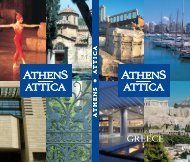Croatian cultural heritage - Business - Hrvatska turistiÄka zajednica
Croatian cultural heritage - Business - Hrvatska turistiÄka zajednica
Croatian cultural heritage - Business - Hrvatska turistiÄka zajednica
You also want an ePaper? Increase the reach of your titles
YUMPU automatically turns print PDFs into web optimized ePapers that Google loves.
16 17<br />
The Basilica is almost invisible from the outside because it blends into the urban structure<br />
of the old city centre of Poreč (18). Yet if we enter into its interior, we will immediately<br />
be impressed by the uniqueness of its structure (22), and in particular the<br />
splendor and uniqueness of the altar (21). Like other Byzantine churches of that era, it<br />
is embellished with rich mosaïcs, and the best preserved are on the apse of the church<br />
(17) and in a special collection in the whole complex of the basilica. Among them, the<br />
most famous is the mosaïc of the fish (20), a historical symbol of Christ, which serves as<br />
a sort of symbol of Poreč, which is therefore sometimes called the city of mosaïcs.<br />
Poreč, of course, is not only defined by the basilica, but also by its picturesque urban<br />
core which holds other beautiful and well preserved buildings from ancient times. Like<br />
other cities in Istria, Poreč also has a local History Museum. In this museum, paintings<br />
have a special role, with the most valuable part of the collection belonging to the once<br />
powerful and rich family Carli (19).<br />
The largest town in Istria, PULA, is located in the extreme South of the Istrian peninsula<br />
and at first glance does not imply the <strong>cultural</strong> richness which it hides, and the beauty<br />
of its surroundings. The reason for this is its location in the plains, the size of the town<br />
and the buildings on its edges. If we enter into the centre of town, we will immediately<br />
be impressed by the monumental and well preserved amphitheatre (28), which testifies<br />
to the extraordinary importance of Pula and Istria since ancient times. This is the sixth<br />
largest Roman amphitheatre in the world and also one of the best preserved.<br />
The amphitheatre was built during the reign of Emperor Vespasian in the first century<br />
after Christ, and its appearance has remained virtually unchanged for two thousand<br />
years. It once served as an arena for cruel gladiator fighting which was watched by up to<br />
20 000 people, and today serves as a tourist attraction and as a stage for various events<br />
(31), most of which are musical performances - from classical music and ballet (30) to<br />
rock concerts (29), which favours a unique atmosphere and the acoustics of the arena.<br />
However, the most famous of all national events is the international film festival held<br />
in July each year.<br />
18<br />
19<br />
20<br />
10



